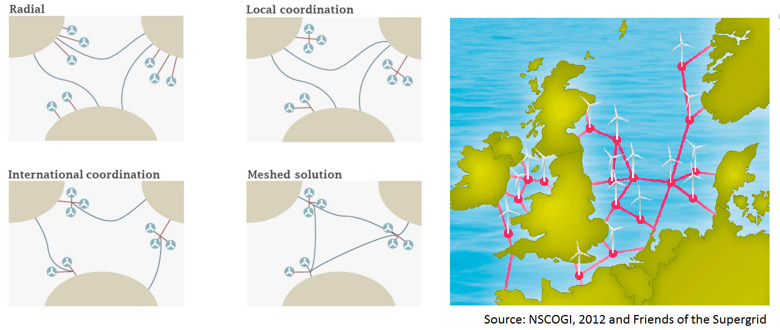Written by Tim Schittekatte
The WindEurope association projects that by 2030, 5% to 11% of the electricity demand in the EU will be covered by offshore wind generation.[1],[2] It is clear that it will cost much money to connect all those wind turbines to shore, but exactly how much will depend strongly on the degree of collaboration between North Sea nations. A study from the European Commission has shown a potential for up to €5.1 billion worth of annual savings in 2030 when a coordinated approach to offshore grid development is undertaken. In the same study, the coordinated offshore grid is shown to be profitable in all assessed scenarios.[3]
Why opting for a meshed network
Such an approach would have the aim to evolve towards a meshed offshore grid, connecting wind turbines to shore and to electricity markets overseas to kill two birds with one stone.

An offshore meshed grid would deliver benefits to offshore generation developers.[4] Firstly, the cost to transport electricity from where it is generated, offshore, to where it is consumed, onshore, would decrease. Fewer cables will be necessary to serve this purpose and economies of scale could be profited from. The environmental impact would be mitigated as well since fewer components would be needed. Secondly, the reliability of electricity delivery would increase, a meshed network offers redundancy, implying that if one cable fails it would not necessarily mean that the electricity generated was lost. Thirdly, next to facilitating the integration of renewable energy generation, a meshed offshore network also connects overseas power systems. Electricity generated offshore can then flow to the onshore market most in need of additional power. As such the revenues obtained from electricity sales will be maximised for offshore wind developers. A general increase in pan-European social economic welfare would result. More precisely, by coupling markets the security of supply of the systems augments, the dispatch of generation can be done more efficiently, and competition between generation companies is increased.
Obstacles to overcome
It is unlikely that this offshore meshed network in the North Sea will be created through a ‘big bang’ approach. Instead, it is expected that it will be build up gradually, link by link. For this gradual build-up take place smoothly there are various challenges to overcome, both technical as regulatory.[5],[6]
A very prominent regulatory issue is the national frames for offshore transmission investment. It is not clear if an offshore grid will be considered, from a regulatory point of view, as a connection for wind farms or interconnections between overseas countries or both. Much depends on the answer to this question.[7] In Germany, for instance, the onshore transmission system operator (TSO) pays for and builds the offshore cables while in the UK a third-party (or the offshore wind developer) builds the offshore cables and the offshore wind developer pays for the cable. In the case of interconnectors, the majority of them are subject to a regulated revenue stream to recuperate the investment, but there are also projects, so-called merchant lines, relying on commercial transactions. It is evident that coordination is hard to achieve in such a non-harmonised setting.
Another issue is (nationalised) renewable support schemes, Today, to benefit from financial support the electricity generated should be fed into the state funding the project.[8] This frame does not facilitate investment in wind turbines connected to two or more nations. This obstacle could be solved with the introduction of cooperation set up under the Renewable Energy Directive.[9] Experiments, for now outside of the offshore context, have been established between nations in order to collaborate in supporting investments in renewable technologies.[10]
A third issue could be how we deal with the operation and trade in the context of an offshore grid which both transports electricity generated offshore and facilitates trade between electricity markets overseas. For example, would wind energy be subject to curtailment when prior commitments for trade take up the interconnector’s capacity? Also, who would operate this offshore grid?
A more regional approach
The previous paragraphs give a non-exhaustive overview of arising regulatory issues; many more questions arise in such a setting. However, it is clear that collaboration among the North Sea countries and the harmonisation of their regulatory regimes for offshore infrastructure development is essential. A regional approach should be favored to avoid an offshore “spaghetti” grid and move gradually towards a beneficial meshed “spider-web-like” offshore grid. [11]
All of these questions should be answered at this early stage of offshore development as the economic case for integrated solutions in grid development is very path dependent; one or several bad choices now, can impede the development of an adequate meshed configuration later. In that respect, it is crucial that the value of investments made today to create more options in the future, so-called anticipatory investments, is captured correctly.
[1] “Wind energy scenarios for 2030”, by The European Wind Association (now Wind Europe), published in August 2015.
[2] Read more information about the status of offshore generation today in Europe
[3] “Study of the benefit of a meshed offshore grid in Northern Seas Region”, by PwC, Tractebel Engineering and ECOFYS for the European Commission, published in July 2014.
[4] Next to offshore wind generation also tidal power generation can be connected to the offshore grid in the future. The first large scale project with a capacity of 398 MW is under construction in Scotland. See for example “Scotland unveils world’s largest tidal stream power project” published in the Financial Times on 12/09/’16. Also there is the plan to connect tidal generation (300 MW) to the France-Alderney-Britain (FAB) interconnector. See for example: http://www.4coffshore.com/windfarms/fab-link-to-transport-tidal-energy-nid3169.html
[5] These obstacles to overcome (both technical as regulatory) are the subject of the EU Horizon2020 project “Progress on Meshed HVDC Offshore Transmission Networks” (https://www.promotion-offshore.net/) of which the Florence School of Regulation (under the European University Institute) is a project partner. For more information about the technical challenges please consult for example “Multi-terminal VSC HVDC for the European supergrid: obstacles” by D. Van Hertem and M. Ghandhari (2010), published in Renewable and Sustainable Energy Reviews.
[6] Two of these regulatory issues, namely the responsibility of the offshore connection and renewable support schemes, were discussed in more depth in previous blog posts.
[7] See also, “Offshore Grids: Towards a Least Regret EU Policy “ THINK report (topic 5) by L. Meeus et al. (2012)
[8] For more details see “The legal and economic impacts of implementing a joint feed-in premium support scheme on the development of an offshore grid” by S. S. Torbaghan et al. (2015), published in Renewable and Sustainable Energy Reviews
[9] For more info please visit: http://ec.europa.eu/energy/en/topics/renewable-energy/renewable-energy-directive/cooperation-mechanisms
[10] In July 2016 the Danish and the German governments signed a cooperation agreement on the mutual opening of auctions for PV installations. See for example: http://www.bmwi.de/EN/Service/search,did=774486.html
[11] See also : “Governing a north sea grid development: the need for a regional framework treaty” by O. Woolley (2013) published in Competition and Regulation in Network Industries






